Paraver Dumb Exporter and SMPI Comparison
Table of Contents
Sitemap
(setq org-babel-default-header-args:R '((:session . "org-R")))
| (:session . org-R) |
For some reason, BigDFT is just impossible to trace in RL with Tau or Scalasca. Either it segfault or it hangs… Surprisingly, it works like a charm with Paraver. Remember we want to compare a RL trace with an SMPI trace. Unfortunately, we haven't found any converter from Paraver files to Tau or OTF or anything that we could later convert to CSV and analyze with R… So I've quickly written a quick and dirty perl script that converts Paraver files to CSV files similar to the ones we obtain with pj_dump.
Paraver Conversion and R visualization
Augustin just sent me a typical paraver trace. Let's convert it:
ls paraver_trace/
| EXTRAE_Paraver_trace_mpich.pcf |
| EXTRAE_Paraver_trace_mpich.prv |
| EXTRAE_Paraver_trace_mpich.row |
The pcf file describes events, the row file defines the
cpu/node/thread mapping and the prv is the trace with all
events. The description of the file format is given here
http://pcsostres.ac.upc.edu/eitm/doku.php/paraver:prv
# use strict; use Data::Dumper; my $prv_input=$input.".prv"; my $pcf_input=$input.".pcf"; open(OUTPUT,"> $output"); sub parse_pcf { my($pcf) = shift; my $line; my(%state_name, %event_name) ; open(INPUT,$pcf) or die "Cannot open $pcf. $!"; while(defined($line=<INPUT>)) { chomp $line; if($line =~ /^STATES$/) { while((defined($line=<INPUT>)) && ($line =~ /^(\d+)\s+(.*)/g)) { $state_name{$1} = $2; } } if($line =~ /^EVENT_TYPE$/) { $line=<INPUT>; $line =~ /[6|9]\s+(\d+)\s+(.*)/g or next; #E.g. , EVENT_TYPE\n 1 50100001 Send Size in MPI Global OP my($id)=$1; $event_name{$id}{type} = $2; $line=<INPUT>; $line =~ /VALUES/g or die; while((defined($line=<INPUT>)) && ($line =~ /^(\d+)\s+(.*)/g)) { $event_name{$id}{value}{$1} = $2; } } } # print Dumper(\%state_name); # print Dumper(\%event_name); return (\%state_name,\%event_name); } sub parse_prv { my($prv,$state_name,$event_name) = @_; my $line; my (%event); open(INPUT,$prv); my($pcf) = shift; while(defined($line=<INPUT>)) { chomp $line; # State records 1:cpu:appl:task:thread : begin_time:end_time : state if($line =~ /^1/) { my($sname); my($state,$cpu,$appli,$task,$thread,$begin_time,$end_time,$state) = split(/:/,$line); if($$state_name{$state} =~ /Group/) { $line=<INPUT>; chomp $line; my($event,$ecpu,$eappli,$etask,$ethread,$etime,%event_list) = split(/:/,$line); (($ecpu eq $cpu) && ($eappli eq $appli) && ($etask eq $task) && ($ethread eq $thread) && ($etime >= $begin_time) && ($etime <= $end_time)) or die "Invalid event!"; $sname = $$event_name{50000002}{value}{$event_list{50000002}}; } else { $sname = $$state_name{$state}; } print OUTPUT "State, $task, MPI_STATE, $begin_time, $end_time, ". ($end_time-$begin_time).", 0, ". $sname."\n"; } # Event records 2:cpu:appl:task:thread : time : event_type:event_value if($line =~ /^2/) { my($event,$cpu,$appli,$task,$thread,$time,@event_list) = split(/:/,$line); # print OUTPUT "$time @event_list\n"; } } } my($state_name,$event_name) = parse_pcf($pcf_input); parse_prv($prv_input,$state_name,$event_name); print "$output";
/tmp/bigdft_8_rl.csv
head /tmp/bigdft_8_rl.csv
| State | 1 | MPI_STATE | 0 | 10668 | 10668 | 0 | Not created |
| State | 2 | MPI_STATE | 0 | 5118733 | 5118733 | 0 | Not created |
| State | 3 | MPI_STATE | 0 | 9374527 | 9374527 | 0 | Not created |
| State | 4 | MPI_STATE | 0 | 17510142 | 17510142 | 0 | Not created |
| State | 5 | MPI_STATE | 0 | 5989994 | 5989994 | 0 | Not created |
| State | 6 | MPI_STATE | 0 | 5737601 | 5737601 | 0 | Not created |
| State | 7 | MPI_STATE | 0 | 5866978 | 5866978 | 0 | Not created |
| State | 8 | MPI_STATE | 0 | 5891099 | 5891099 | 0 | Not created |
| State | 1 | MPI_STATE | 10668 | 25576057 | 25565389 | 0 | Running |
| State | 2 | MPI_STATE | 5118733 | 18655258 | 13536525 | 0 | Running |
OK. Conversion seems fine. It's a little messy and some stuff is hardcoded but it does the job. Let's load it in R.
options( width = 200 ) library(plyr) library(ggplot2) read_tau_trace <- function(file) { df <- read.csv(file, header=FALSE, strip.white=TRUE) names(df) <- c("Nature","ResourceId","Type","Start","End","Duration", "Level", "Value") df = df[!(names(df) %in% c("Nature","Type", "Level"))] df$Origin=file df } df <- read_tau_trace(input) # Let's convert from micro-seconds to seconds df$End <- as.numeric(df$End)/1E9 df$Start <- as.numeric(df$Start)/1E9 df$Duration <- as.numeric(df$Duration)/1E9 head(df)
Use suppressPackageStartupMessages to eliminate package startup messages. ResourceId Start End Duration Value Origin 1 1 0 0.000010668 0.000010668 Not created /tmp/bigdft_8_rl.csv 2 2 0 0.005118733 0.005118733 Not created /tmp/bigdft_8_rl.csv 3 3 0 0.009374527 0.009374527 Not created /tmp/bigdft_8_rl.csv 4 4 0 0.017510142 0.017510142 Not created /tmp/bigdft_8_rl.csv 5 5 0 0.005989994 0.005989994 Not created /tmp/bigdft_8_rl.csv 6 6 0 0.005737601 0.005737601 Not created /tmp/bigdft_8_rl.csv
Fine. Now, let's make a Gantt Chart.
# Reorder time from most running. df_profile <- ddply(df, c("Value"), summarize, Duration = sum(as.numeric(Duration))) new_value_order <- df_profile[with(df_profile, order(-Duration)),]$Value df_profile$Value <- factor(df_profile$Value, levels=new_value_order) df_profile[with(df_profile, order(-Duration)),] df$Value <- factor(df$Value, levels=new_value_order) ggplot(df) + theme_bw() + scale_fill_brewer(palette="Paired") + geom_rect(aes(xmin=Start,xmax=End, ymin=ResourceId, ymax=ResourceId+1,fill=Value))

And voilà. Now, we have to compare it more finely with an SMPI trace…
First Comparison with SMPI
Let's try with one Augustin just sent me.
pj_dump $input | grep State | sed -e 's/PMPI/MPI/g' -e 's/rank-//' -e 's/computing/Running/' > $output echo $output
/tmp/bigdft_8_smpi.csv
dfs <- read_tau_trace(input)
head(dfs)
ResourceId Start End Duration Value Origin 1 7 0.000000 0.000084 0.000084 Running /tmp/bigdft_8_smpi.csv 2 7 0.000084 0.000424 0.000340 MPI_Barrier /tmp/bigdft_8_smpi.csv 3 7 0.000424 0.000444 0.000020 Running /tmp/bigdft_8_smpi.csv 4 7 0.000444 0.000510 0.000066 MPI_Bcast /tmp/bigdft_8_smpi.csv 5 7 0.000510 0.000513 0.000003 Running /tmp/bigdft_8_smpi.csv 6 7 0.000513 0.000620 0.000107 MPI_Bcast /tmp/bigdft_8_smpi.csv
# Reorder time from most running. ggplot(dfs) + theme_bw() + scale_fill_brewer(palette="Paired") + geom_rect(aes(xmin=Start,xmax=End, ymin=ResourceId, ymax=ResourceId+1,fill=Value))

Let's plot them side by side
# Reorder time from most running. df2 <- rbind(df,dfs) ggplot(df2) + theme_bw() + scale_fill_brewer(palette="Paired") + geom_rect(aes(xmin=Start,xmax=End, ymin=ResourceId, ymax=ResourceId+1,fill=Value)) + facet_wrap(~Origin, ncol=1)
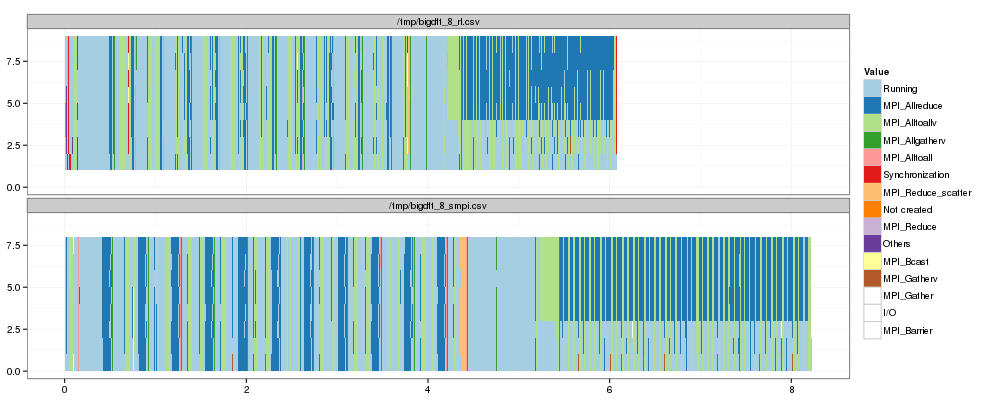
OK. That's a first step but obviously, our estimation of
MPI_Allreduce is quite pessimistic. It's likely to be explained by
the fact that our implementation of this collective in SMPI does not
correspond at all to the one of RL…
Mmmmh, let's limit to the first phase:
df <- df[df$End<=max(df[df$Value == "MPI_Reduce_scatter",]$End),] dfs <- dfs[dfs$End<=max(dfs[dfs$Value == "MPI_Reduce_scatter",]$End),] df2 <- rbind(df,dfs)
And let's plot them side by side again
# Reorder time from most running. ggplot(df2) + theme_bw() + scale_fill_brewer(palette="Paired") + geom_rect(aes(xmin=Start,xmax=End, ymin=ResourceId, ymax=ResourceId+1,fill=Value)) + facet_wrap(~Origin, ncol=1)
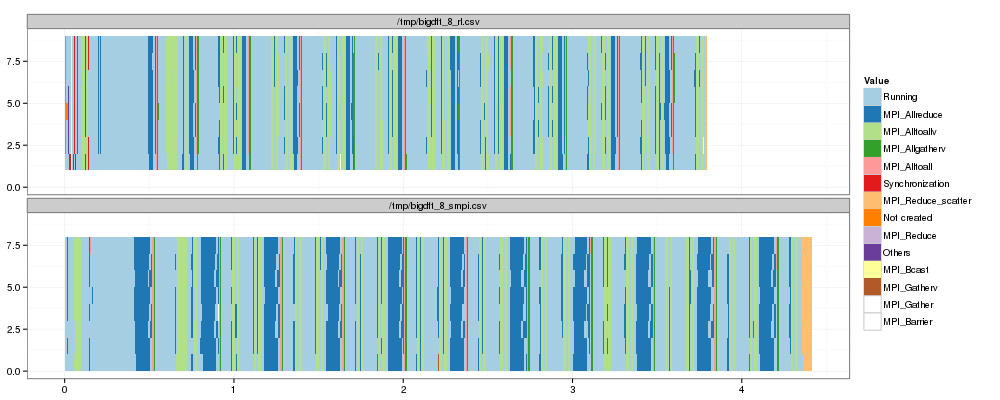
Now, let's compare "state distributions".
# Reorder time from most running. df_sum <- ddply(df2, c("Value","ResourceId","Origin"),summarize, Duration = sum(Duration)) ggplot(df_sum, aes(x=Value, y=Duration, color=Origin)) + theme_bw() + theme(axis.text.x = element_text(angle = 90, hjust = 1)) + geom_boxplot() + geom_jitter(alpha=.4)
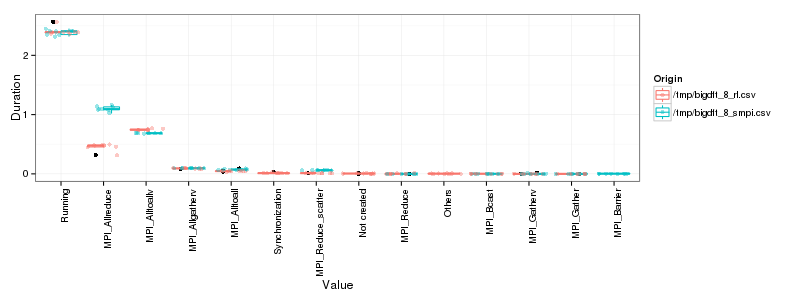
OK, so as expected the main difference lies in MPI_Allreduce. There
is also a small difference in MPI_Alltoallv and
MPI_Reduce_scatter. The other differences do not seem significant at
this level of detail.
Using a "better" Allreduce implementation in SMPI
OK. Last attempt with a new trace that uses another implementation of
Allreduce.
/tmp/bigdft_8_smpi_rdb.csv
dfs2 <- read_tau_trace(input) dfs2 <- dfs2[dfs2$End<=max(dfs2[dfs2$Value == "MPI_Reduce_scatter",]$End),]
Again, let's display them side by side:
# Reorder time from most running. df2 <- rbind(df,dfs,dfs2) ggplot(df2) + theme_bw() + scale_fill_brewer(palette="Paired") + geom_rect(aes(xmin=Start,xmax=End, ymin=ResourceId, ymax=ResourceId+1,fill=Value)) + facet_wrap(~Origin, ncol=1)
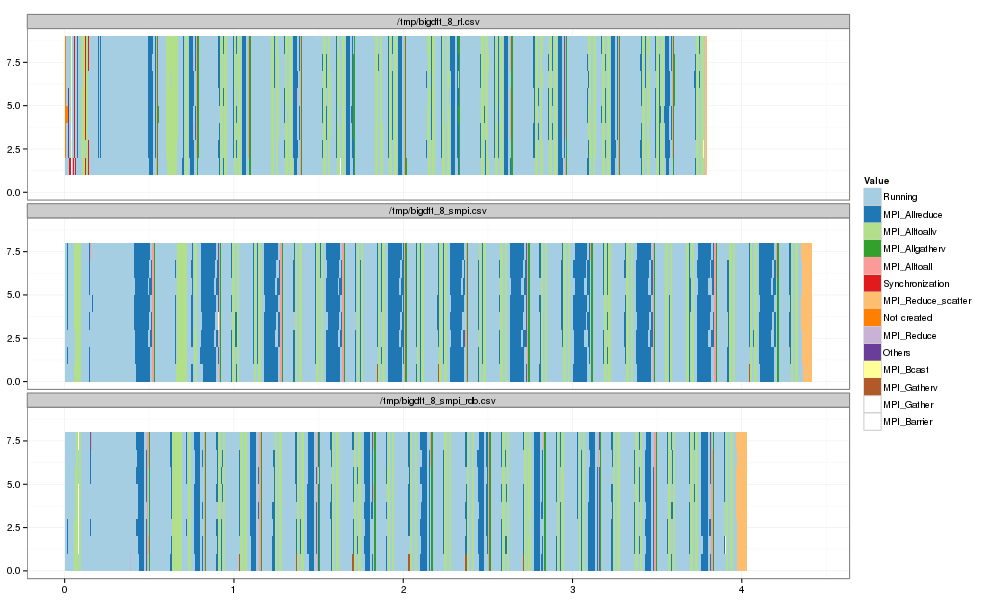
# Reorder time from most running. df_sum <- ddply(df2, c("Value","ResourceId","Origin"),summarize, Duration = sum(Duration)) ggplot(df_sum, aes(x=Value, y=Duration, color=Origin)) + theme_bw() + theme(axis.text.x = element_text(angle = 90, hjust = 1)) + geom_boxplot(position="dodge") + geom_jitter(alpha=.3)
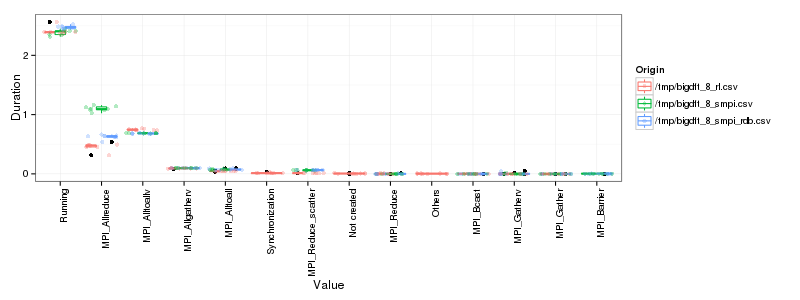
That's better. It's not perfect yet but it's improving and we may still not have the true algorithm…
Entered on








